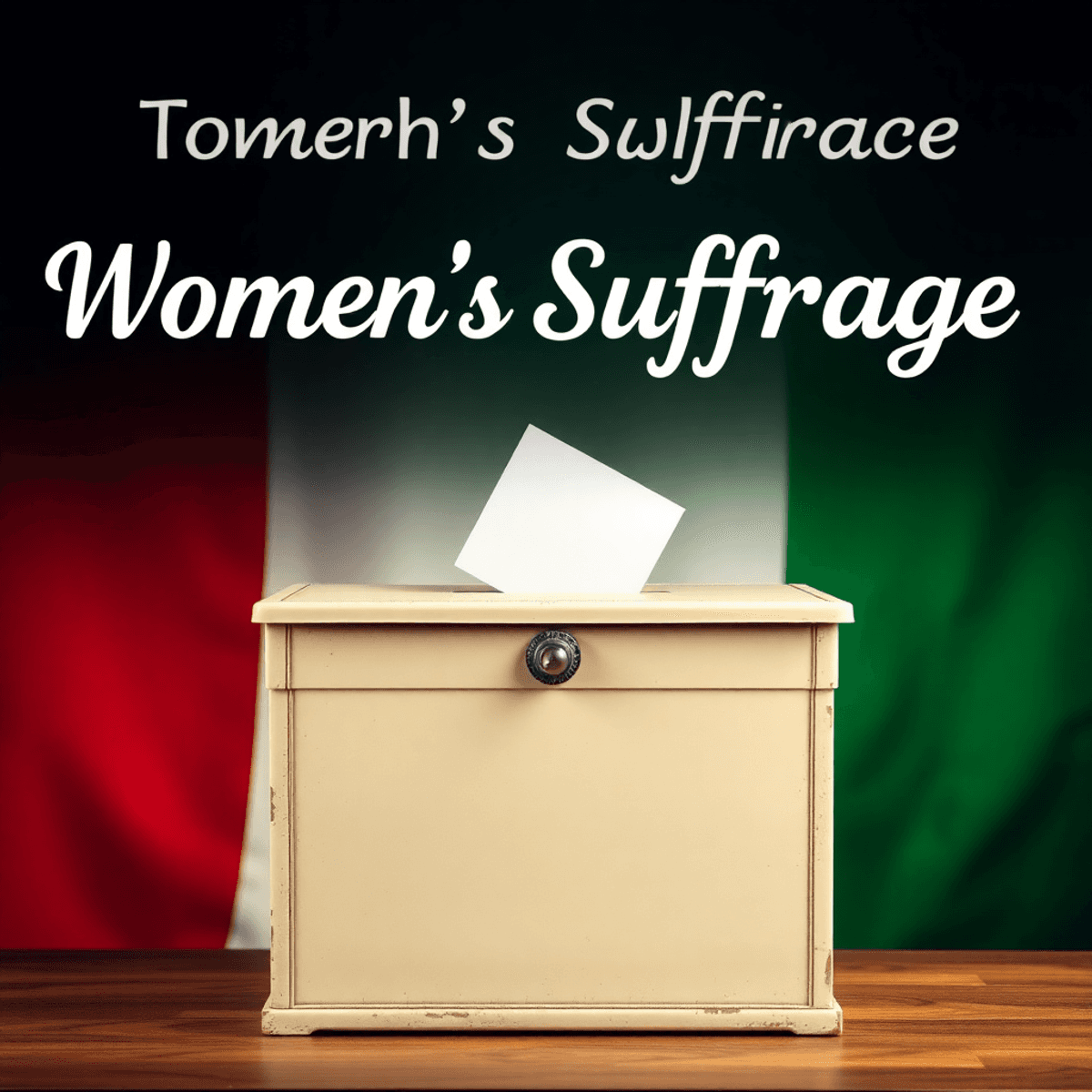Introduction
In 1945, Italy underwent a significant change as women finally gained the right to vote after being denied for so long. This important achievement meant more than just being able to vote – it represented a major shift in Italian society’s view of women as equal citizens.
The journey towards women’s suffrage in Italy began after World War II and the end of fascism. After years of being excluded from politics and facing discrimination based on their gender, Italian women were able to cast their votes for the first time in 1946. This was during a referendum that would decide what type of government Italy would have in the future.
This hard-won victory opened doors for women’s participation in public life, challenging traditional gender roles and laying the groundwork for future feminist movements. The impact of this milestone continues to resonate in modern Italy, where women’s political representation and social equality remain central topics in national discourse.
Key Achievement: Italian women secured their right to vote through Decree No. 23 on February 1, 1945, establishing universal suffrage for all Italian citizens aged 21 and above.
The Historical Context of Women’s Suffrage in Italy
Women’s Roles in Pre-Fascist Italy
In pre-fascist Italy, women’s roles were primarily focused on domestic responsibilities. The existing social structure limited women to managing the household, raising children, and supporting their husbands’ pursuits. Italian society viewed women’s involvement in politics as unnecessary and potentially disruptive to the traditional family unit.
Changes Under Mussolini’s Fascist Regime
The rise of Mussolini’s fascist regime in 1922 brought significant changes to women’s status in Italy. The fascist ideology promoted a specific vision of womanhood:
- Demographic Campaign: Women were expected to be prolific mothers
- Economic Restrictions: Laws limited female employment to protect “male jobs”
- Educational Barriers: Girls’ education focused on domestic skills
- Political Exclusion: Complete denial of women’s political participation
Under fascism, women faced severe limitations in public life. The regime’s policies actively discouraged women’s independence through:
- Reduced access to professional positions
- Marriage incentives tied to childbearing
- Strict control over women’s organizations
- Propaganda promoting the “ideal fascist woman”
Limited Voting Rights Before 1945
Before 1945, voting rights remained exclusively male-dominated. The few exceptions included:
- Widows managing family businesses
- Women with specific educational qualifications
- Female property owners in select municipalities
These limited rights affected only a tiny fraction of the female population, highlighting the urgent need for comprehensive suffrage reform. The oppressive policies during the fascist period created a stark contrast between Italy and other European nations where women’s rights movements had gained momentum.
Consequences of Male-Dominated Politics
The absence of women’s voices in Italian politics resulted in policies that reinforced gender inequality. Male-dominated legislative bodies enacted laws without considering women’s perspectives, perpetuating a cycle of discrimination in:
- Property rights
- Employment opportunities
- Educational access
- Family law
- Political representation
This historical context underscores the importance of understanding the impact of gender inequality on societal development and the necessity for inclusive political representation.
The Struggle for Suffrage: From Fascism to Feminism
Italian women’s resistance during World War II marked a turning point in their fight for political equality. The partisan movement saw women taking active roles as fighters, messengers, and strategists against fascist forces. These brave women, known as partigiane, demonstrated their capability to participate in political and military affairs, challenging traditional gender roles.
Key Women’s Resistance Groups:
- Gruppi di Difesa della Donna (GDD)
- Unione Donne Italiane (UDI)
- Fronte delle Donne
The partisan movement created a network of women activists who later became instrumental in the suffrage movement. Notable figures like Ada Gobetti and Teresa Noce emerged as leaders, combining their anti-fascist resistance with demands for women’s political rights.
Women’s participation in the resistance transformed their social consciousness. Their direct involvement in fighting fascism strengthened their argument for full citizenship rights, including voting. The experience of war-time responsibility proved women’s capacity for political engagement and leadership.
Notable Achievements of Women’s Resistance:
- Establishment of underground communication networks
- Organization of strikes in factories
- Protection of Jewish families and Allied soldiers
- Distribution of anti-fascist propaganda
The feminist movement gained momentum through organizations like the UDI, which coordinated efforts across Italy. These groups organized demonstrations, published newsletters, and lobbied political leaders for women’s suffrage. Their activism highlighted the connection between anti-fascist resistance and women’s rights.
The resistance period saw women from different social classes unite in their struggle. Working-class women joined forces with intellectuals and aristocrats, creating a broad-based movement for political rights. This unity proved crucial in pressuring the post-war government to grant women voting rights.
Women’s participation in the resistance movement demonstrated their readiness for full political participation. Their actions during this period created a strong foundation for the feminist movements that would continue to fight for gender equality in post-war Italy.
Legal Milestones: Granting Women the Right to Vote
The path to women’s suffrage in Italy culminated in a historic decree issued by the Council of Ministers on February 1, 1945. This landmark legislation granted Italian women aged 21 and above the right to vote in national elections – a right previously reserved exclusively for men.
The legal framework for women’s suffrage emerged through several key reforms:
- Decree No. 23/1945: Established universal suffrage for women in national elections
- Administrative voting rights: Extended in March 1946 for local elections
- Constitutional Assembly participation: Women gained the right to be elected to public office
The implementation of these voting rights faced practical challenges. The Italian government needed to:
- Create new electoral lists including women
- Issue voting cards to female citizens
- Train polling station workers on new procedures
- Establish verification systems for female voters
These legal changes represented a fundamental shift in Italian democracy. The reforms emerged during Italy’s transition from fascism to democratic governance, reflecting broader societal changes in post-war Europe.
Women’s participation in the political process became legally protected through Article 48 of the Italian Constitution, which states:
“All citizens, male and female, who have reached majority age, are voters.”
The inclusion of women in the electoral process marked Italy’s commitment to democratic principles and gender equality in political representation. These legal reforms set the stage for women’s active participation in shaping Italy’s political future.
The First Votes: Shaping Modern Italy’s Political Landscape
The June 2, 1946 elections marked a transformative moment in Italian history. Women’s participation reshaped the nation’s political landscape through two critical votes:
- The institutional referendum to choose between monarchy and republic
- The election of representatives to the Constituent Assembly
Women voters turned out in unprecedented numbers – 89% of eligible female voters cast their ballots. Their decisive participation helped establish Italy as a republic, with 54.3% voting against the monarchy.
The election results reflected women’s growing political influence:
- 21 women were elected to the Constituent Assembly
- Women representatives contributed to drafting Italy’s new democratic constitution
- Female voters demonstrated their power to influence major national decisions
This historic election set several precedents:
- Equal political participation became a tangible reality
- Women’s voices gained recognition in policy-making
- Traditional gender roles in Italian politics began shifting
The election results demonstrated women’s capability to engage in political discourse and shape governmental decisions. Their votes contributed to establishing democratic institutions that would guide Italy’s post-war reconstruction and development.
The presence of women in the Constituent Assembly brought fresh perspectives to constitutional debates, particularly regarding family law, workplace equality, and social welfare policies.
Impact on Italian Society: Progress and Ongoing Challenges
The acquisition of voting rights sparked significant social transformations in Italian society. Women’s participation in politics grew steadily, with female representatives entering local councils and the national parliament. This political engagement challenged traditional gender roles, encouraging women to pursue education and careers beyond domestic responsibilities.
Progress in Women’s Rights
The 1960s and 1970s witnessed remarkable progress in women’s rights:
- Introduction of divorce laws (1970)
- Legalization of family planning services (1971)
- Reform of family law establishing equality between spouses (1975)
- Legalization of abortion (1978)
Ongoing Gender Disparities
Despite these achievements, contemporary Italy faces persistent gender disparities. Women’s representation in politics remains below European averages, with female parliamentarians constituting only 35% of seats. The gender pay gap stands at 5.7%, while the employment gap reaches 19.8%, reflecting deep-rooted inequalities in the workforce.
Challenges Facing Italian Women
Several challenges continue to affect Italian women:
- Limited access to leadership positions in corporations
- Unequal distribution of domestic responsibilities
- Discrimination in hiring practices
- Workplace harassment
- Insufficient childcare support
Recent statistics paint a complex picture:
Only 28% of Italian companies have women in top management positions, while 68% of unpaid care work falls on women’s shoulders.
Impact of COVID-19
The COVID-19 pandemic exacerbated existing inequalities, with women bearing the brunt of job losses and increased domestic responsibilities. Data shows that 98% of those who lost jobs during the pandemic were women, highlighting the fragility of progress made.
Cultural Attitudes and Gender Roles
Cultural attitudes toward gender roles evolve slowly in Italy. Traditional expectations about motherhood and family responsibilities often conflict with career aspirations, creating additional pressure on women seeking professional advancement. These societal norms influence everything from hiring practices to promotion opportunities, perpetuating systemic barriers to gender equality.
Conclusion: The Legacy of Italian Women’s Suffrage
The 1945 milestone of Italian women gaining voting rights sparked a transformation that resonates through generations. This achievement stands as a powerful reminder of the persistent struggle for gender equality, inspiring movements across borders and decades.
The impact of Italian women’s suffrage extends beyond the ballot box:
- It established a foundation for women’s participation in political decision-making
- It challenged traditional gender roles in Italian society
- It created pathways for future generations of female leaders
You can contribute to this ongoing legacy:
- Support women candidates in local and national elections
- Advocate for gender-balanced representation in leadership positions
- Share stories of women’s historical achievements with younger generations
- Challenge gender stereotypes in your community
The journey that began with Italian women’s suffrage in 1945 continues today. Each vote cast by an Italian woman honors the sacrifices of those who fought for this fundamental right and reinforces the importance of equal participation in democracy.
FAQs (Frequently Asked Questions)
When did Italian women gain the right to vote?
Italian women gained the right to vote on February 1, 1945, marking a crucial milestone in the fight for gender equality in Italy.
What was the impact of fascism on women’s rights in Italy?
During fascism, particularly under Mussolini’s regime, women’s roles were limited and their access to voting and public life was severely restricted, which highlighted the need for change and greater political participation.
How did World War II influence the women’s suffrage movement in Italy?
World War II played a significant role in igniting a desire for political equality among women, as they actively participated in resistance against fascism, leading to the rise of feminist movements advocating for voting rights.
What legal changes led to the granting of voting rights to Italian women?
The legal milestones that led to women’s suffrage included constitutional changes enacted on February 1, 1945, which were significant reforms within the broader context of establishing democracy in Italy.
What was the significance of the first elections where women could vote in Italy?
The June 2, 1946 elections were historic as they marked the first time women cast their votes in Italy, significantly shaping modern Italy’s political landscape and advancing gender equality.
What ongoing challenges do women face in Italy despite gaining voting rights?
Despite the progress made since suffrage, women in Italy still face challenges such as gender disparities in politics and society. Ongoing issues include underrepresentation in leadership roles and persistent social inequalities.
Written by
Joshua Gonzales
You may also interested in:

How did Italian humanists view the education of women?
Explore how Italian humanists viewed women's education during the Renaissance, challenging societal norms and advocating for change.
Do Italian women drink wine when pregnant?
Explore the cultural norms and health risks of wine consumption during pregnancy among Italian women. Balance tradition with safety.
